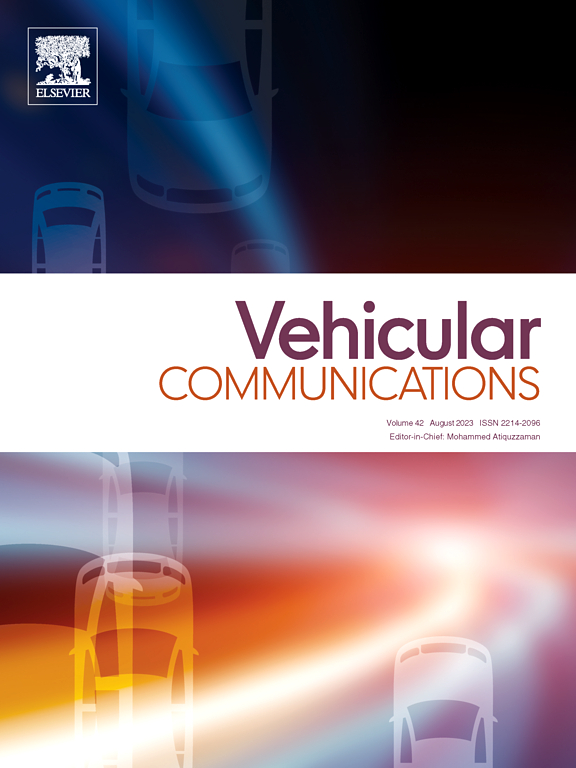统计CSI下无人机机载IRS辅助ISAC系统的能效优化
IF 6.5
2区 计算机科学
Q1 TELECOMMUNICATIONS
引用次数: 0
摘要
集成传感与通信(ISAC)系统有利于提高通信和传感能力,但其性能受到动态车辆环境中信号阻塞的显著影响。用于空对地通信和传感的无人机(UAV)安装的智能反射面(IRS)可以显著提高覆盖范围和部署灵活性。然而,无人机机载IRS (UIRS)的额外功耗仍然是一个挑战。为了缓解这一问题,我们提出了一种新的uirs辅助ISAC系统,该系统旨在通过优化无人机轨迹、IRS无源波束形成和基站(BS)有源波束形成,最大限度地提高通信能效(EE),同时满足感知服务质量(QoS)要求。由于无线信道的复杂性和动态性,获取信道状态信息(CSI)是一个挑战,特别是考虑到无人机的机动性和IRS的被动模式。因此,本方案采用统计CSI。将优化问题重新表述为易于处理的形式,并将其分解为三个子问题来解决,包括在EE计算中使用Dinkelbach变换进行分数规划,在无人机轨迹优化中使用逐次凸逼近(SCA),以及在主动和被动波束形成设计中使用半确定松弛(SDR)。基于交替优化(AO)的框架迭代求解所有子问题,证明了算法的收敛性和计算效率。仿真结果表明,与基准方案相比,所提出的uirs辅助ISAC系统在通信和感知性能方面都有显著提高。本文章由计算机程序翻译,如有差异,请以英文原文为准。
Energy efficiency optimization for UAV-mounted IRS assisted ISAC systems under statistical CSI
Integrated Sensing and Communication (ISAC) systems are advantageous for enhancing both communication and sensing capabilities, but their performance is significantly impacted by signal blockages in dynamic vehicular environments. An Unmanned Aerial Vehicle (UAV)-mounted Intelligent Reflective Surface (IRS) for air-to-ground communication and sensing can significantly enhance coverage and deployment flexibility. However, the additional power consumption of the UAV-mounted IRS (UIRS) remains a challenge. To mitigate this, we propose a novel UIRS-assisted ISAC system that aims to maximize communication energy efficiency (EE) while meeting sensing quality-of-service (QoS) requirements by optimizing the UAV trajectory, IRS passive beamforming, and base station (BS) active beamforming. Due to the complex and dynamic nature of wireless channels, acquiring Channel State Information (CSI) is challenging, especially with the UAV's mobility and the passive mode of IRS. Therefore, statistical CSI is adopted in the proposed scheme. The optimization problem is reformulated into a tractable form and solved by decomposing it into three subproblems, which include using the Dinkelbach transformation for fractional programming in EE calculation, Successive Convex Approximation (SCA) for UAV trajectory optimization, and Semi-Definite Relaxation (SDR) for both active and passive beamforming designs. An alternating optimization (AO)-based framework iteratively solves all subproblems, with proven algorithm convergence and computational efficiency. Simulation results demonstrate that the proposed UIRS-assisted ISAC system significantly improves both communication and sensing performance compared to benchmark schemes.
求助全文
通过发布文献求助,成功后即可免费获取论文全文。
去求助
来源期刊

Vehicular Communications
Engineering-Electrical and Electronic Engineering
CiteScore
12.70
自引率
10.40%
发文量
88
审稿时长
62 days
期刊介绍:
Vehicular communications is a growing area of communications between vehicles and including roadside communication infrastructure. Advances in wireless communications are making possible sharing of information through real time communications between vehicles and infrastructure. This has led to applications to increase safety of vehicles and communication between passengers and the Internet. Standardization efforts on vehicular communication are also underway to make vehicular transportation safer, greener and easier.
The aim of the journal is to publish high quality peer–reviewed papers in the area of vehicular communications. The scope encompasses all types of communications involving vehicles, including vehicle–to–vehicle and vehicle–to–infrastructure. The scope includes (but not limited to) the following topics related to vehicular communications:
Vehicle to vehicle and vehicle to infrastructure communications
Channel modelling, modulating and coding
Congestion Control and scalability issues
Protocol design, testing and verification
Routing in vehicular networks
Security issues and countermeasures
Deployment and field testing
Reducing energy consumption and enhancing safety of vehicles
Wireless in–car networks
Data collection and dissemination methods
Mobility and handover issues
Safety and driver assistance applications
UAV
Underwater communications
Autonomous cooperative driving
Social networks
Internet of vehicles
Standardization of protocols.
 求助内容:
求助内容: 应助结果提醒方式:
应助结果提醒方式:


